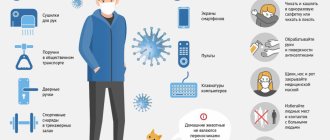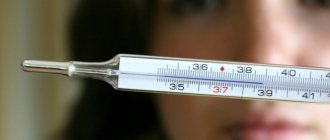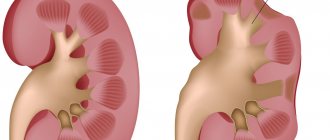Low-grade fever (low-grade fever) is a slight (37 - 37.9'C) increase in body temperature observed over a long period of time (from several weeks). It can be observed continuously throughout the day or occur at certain hours.
Low-grade fever is a symptom of many diseases, and therefore can coexist with different symptoms. In some cases, a persistent increase in temperature is the patient's only complaint. The most common companions of low-grade fever are increased heart rate, weakness, drowsiness, and lack of appetite.
Low-grade fever is primarily a consequence of the restructuring of thermoregulatory processes in the body. It is caused by an acceleration of metabolism or dysfunction of the thermoregulation center due to infectious, allergic or any other influences.
Important! Low-grade fever can be a symptom of a low-grade inflammatory process!
The main diseases manifested by low-grade fever:
- Chronic infectious diseases (chronic tuberculosis, brucellosis, sinusitis, pyelonephritis, parasitic lesions, cytomegalovirus, herpes, mononucleosis, sexually transmitted diseases and many other focal infections in a chronic form);
- Diseases associated with impaired immune response (rheumatism, rheumatoid arthritis, vasculitis, post-infarction syndrome). This group also includes diseases of an allergic nature;
- Malignant neoplasms (leukemia, lymphoma, hepatoma, kidney adenocarcinoma, etc.);
- Diseases of the endocrine system ( pathological menopause, thyrotoxicosis, pheochromocytoma, etc.);
- Diseases of the central nervous system of various etiologies ( traumatic brain injuries, neuroinfections, etc.).
Low-grade fever in children, especially young children, often has no connection with any pathology. It occurs due to the body’s thermoregulation not yet established. Children's body temperature rises after physical activity, overheating, and in infants after eating.
One of the common causes of persistent low-grade fever is psychological and mental stress, as well as stress, accompanied by general poor health, dizziness, and shortness of breath.
What symptoms should parents be wary of?
If in children under the age of one year a temperature of 37.2°C is considered normal, then as the child grows older, such indicators cease to be considered normal. As a rule, in addition to an increase in body temperature to subfebrile levels, the child may be bothered by:
- lethargy and apathy, the baby is not as active as usual;
- poor appetite, refusal of food and water;
- restless sleep, nervousness and moody behavior before bedtime;
- increased sweating, clothes become wet after sleep;
- confusion and rapid breathing.
We draw the attention of parents to the fact that the temperature does not indicate the severity of the disease. The symptoms listed above speak about this best.
Diagnosis and treatment
If you have persistent low-grade fever, you should consult a therapist. At the Medicenter, consultations are conducted by a highly qualified therapist with extensive experience. The doctor will quickly and reliably diagnose the cause of low-grade fever and begin treating the disease, not the symptom!
Before visiting a doctor, the patient is recommended to measure body temperature every 3 hours (excluding sleep time) and record the data for 1-2 weeks. The records must be shown to the doctor. This will help him in collecting anamnesis and drawing up an individual examination plan.
It is advisable for women not to carry out this test during menstruation, because... An increase in temperature may be one of the manifestations of premenstrual syndrome.
Due to the wide range of diseases that occur against the background of low-grade fever, diagnosing its cause presents some difficulties. Particular emphasis is placed on collecting patient complaints, as well as an initial examination. First of all, diseases of infectious etiology are excluded, such as tuberculosis, which is often asymptomatic.
In almost every case, a patient with low-grade fever needs to undergo a general and biochemical blood test, a general urinalysis, electrocardiography, and undergo a chest x-ray. If signs of infection are detected, the doctor conducts a targeted search for the source of infection (virus).
If the doctor has a more clear diagnostic version, he may refer the patient for special studies (gynecological, urological, ultrasound diagnostics of internal organs, blood tests for hormones) or for consultation with a specialized specialist.
Diagnosis and treatment of some diseases that occur against the background of low-grade fever require hospitalization of the patient.
Treatment of low-grade fever with antipyretics is rarely practiced. The underlying cause of the disease is subject to treatment.
Important! If you suspect low-grade fever, you should not delay a visit to the doctor, because This symptom is characteristic of many serious diseases, in particular HIV infection.
If outpatient examinations are not possible, Medicenter doctors make house calls to all districts of St. Petersburg. Trips to the suburbs of St. Petersburg are negotiated separately.
Is it necessary to lower the temperature to 37.5 °C?
It's no secret that an increase in temperature is the body's immune response to infectious aggression that has entered the body. At elevated temperatures, pathogenic viruses and microbes die, so it is not recommended to bring it down to 38°C.
These thermometer readings are not a reason to take antipyretics; it is better to give the body the opportunity to use its own defense mechanisms as efficiently as possible.
It is possible to bring down a low-grade fever only if it is poorly tolerated by the child, there are signs of severe intoxication, or there is a high risk of developing cardiac complications. In such cases, it is necessary to consult a doctor as soon as possible.
However, at a temperature above 38.5°C, it is already worth taking measures to reduce it, as the situation may become more complicated.
Fever and menstrual cycle
In women, body temperature is interconnected with the menstrual cycle and hormonal fluctuations. During ovulation, symptoms of low-grade fever may occur, which persist until the onset of menstruation. This is an individual physiological norm. In some women, low-grade fever is accompanied by pregnancy. Most often this occurs in the first trimester, which is due to increased production of progesterone. This hormone affects the thermoregulation center in the brain. That is why in pregnant women the temperature can rise to 37.2-37.40C. According to statistics, a similar phenomenon occurs in 3-5% of women. Most often, low-grade fever during pregnancy is accompanied by drowsiness, fatigue, and changes in appetite. By 12-14 weeks the situation will normalize.
If low-grade fever during pregnancy is not associated with infection, the increase does not have a negative effect on the development of the fetus. If there are complaints or alarming symptoms, a pregnant woman should undergo an examination to determine the cause of poor health.
How to measure temperature correctly?
Before worrying about elevated body temperature, it is worth considering whether the indicator is measured correctly. After all, no one is immune from banal errors, and errors when measuring temperature can be significant. Part of the problem may be a thermometer that is faulty.
If everything is in order with the thermometer, you should pay attention to possible flaws during the measurement procedure. Body temperature is usually measured in the armpit - follow this traditional recommendation to understand the temperature constant. Measuring temperature rectally may give slightly elevated readings, which is normal.
When measuring the indicator, you must be in a room with the usual ambient temperature, be in a calm and relaxed state. You should not take measurements after increased physical activity, unless this is the purpose of the experiment. In this case, the body temperature may differ slightly from usual.
When measuring the indicator, take into account the time when the thermometer is placed. For the morning hours, it is quite normal for the reading to be slightly lower than usual, and in the evening the mercury column, creeping towards around 37, should not make you worry - temperature fluctuations during the day are quite possible and happen to most people. It is best to measure the temperature at the same time in order to track the dynamics of the indicator and notice its increase in time.
Low-grade fever during exercise and stress
If you are in the heat or in a very heated room, dressed too warmly, this affects your body temperature, causing it to rise. Low-grade fever due to overheating is short-term. As soon as the ambient temperature returns to normal, the body temperature also returns to normal.
The same happens during physical activity, which activates all processes and accelerates blood circulation. During heat and stress, the internal temperature can rise by two degrees or more. In this case, the skin, on the contrary, cools due to the release of sweat, as the hypothalamus strives to establish a balance between the formation and release of heat.
Heat
{banner_banstat7}
High temperature is considered to be pyretic and hyperpyretic indicators. Pyretic temperature is considered to be from 39 degrees to 40.9. A reading of 41 degrees and above is called hyperpyretic. From Greek this word is translated as “fever” - it vividly describes the condition of a patient with such a temperature.
Usually, a pyretic temperature is accompanied by a number of other unpleasant and life-threatening symptoms - aches in the muscles and joints begin, pain in the eyes, photophobia, increased sweating provokes dehydration. In severe situations, a person experiences hallucinations, delusions, the excretory function is disrupted, the body is exposed to intoxication, cardiac activity and the functioning of the respiratory system are disrupted.
Reduced body temperature
{banner_banstat10}
Reduced body temperature in humans is no less a problem than increased body temperature. This indicator is considered to be a temperature below 36˚C. Hypothermia also leads to disturbances in the functioning of the body. Patients with low body temperature are easy to recognize - they are prone to drowsiness, apathy, depression, and suffer from tachycardia. Usually have elevated blood glucose levels. Metabolic processes in such people are slowed down, which cannot but affect the functioning of the heart muscle and respiratory system. When the temperature drops critically to 27 degrees, death occurs.
Low-grade fever when taking medications
Low-grade fever of drug etiology is a common phenomenon. Many drugs provoke an increase in temperature. This list includes barbiturates, antituberculosis drugs, drugs of the penicillion group, cephalosporins, atropine, heparin. The temperature may rise if a person is being treated with antibiotics or chemotherapy drugs. In the first case, this is due to the production of endotoxins, in the second, due to the breakdown of tumor cells.
The body may also react with a low-grade fever to the administration of a vaccine or invasive medical procedures (dental treatment, prosthetics).
As a rule, such an adverse reaction occurs at the beginning of treatment, occasionally after a few days or weeks. In addition to fever, the patient experiences other signs of hypersensitivity to the components of the drug. This may include a rash, itching, dizziness, and nausea.
Low-grade fever of drug origin disappears within two days after discontinuation of the drug.
Normal human temperature
{banner_banstat0}
The concept of a normal body temperature of 36.6 degrees is outdated today. Doctors are increasingly trying not to get attached to specific numbers. Therefore, such a temperature should be called ideal, falling within the boundaries of the norm, but not the only correct indicator, when all other numbers automatically go into the category of pathological.
The normal temperature is considered to be 36-37 degrees.
Research by scientists has demonstrated that the human body temperature changes several times per day. Therefore, it would simply be wrong to single out any one indicator of the norm. The temperature indicator is also affected by a person’s age, gender, and even the type of activity.
How to shoot down?
{banner_banstat9}
To lower body temperature, it is necessary to use antipyretic drugs. They are presented in any pharmacy with a wide variety of products, so it will not be difficult to purchase good medicine for both adults and children.
Adult patients with extreme heat should use single-component medications based on paracetamol or ibuprofen. Everyone knows the trade names of such drugs - Panadol, Ibuprofen, Efferalgan and others. There are also multicomponent medications that contain ibuprofen or paracetamol along with other components, but they help no worse than single-component medications. These drugs include Theraflu.
A doctor will help you choose a drug, but if it is not possible to consult a doctor, then it is better to prefer drugs from the first group. It is recommended to be careful with analgin and aspirin - they cause a number of side effects, and are strictly prohibited in childhood due to the risk of Reye's syndrome.
The choice of drugs for children is based on the same principle as for adults. For children, special lines of antipyretic drugs have been developed that will help to gently and carefully return the indicator to normal or at least significantly reduce it. Low-grade fever in a child is reduced by the following means:
- Nurofen for children (from 6 years old);
- Cefekon D (from 1-3 months, from 3 months to 3 years, from 3 to 12 years);
- Children's Panadol (syrup from 3 months);
- Nurofen (syrup from 3 months);
- Rinza (from 3 years old);
- Maxicold (from 3 months).
When choosing a drug, you must first take into account age recommendations and purchase strictly those recommended by age. They contain different dosages of the active substance.









